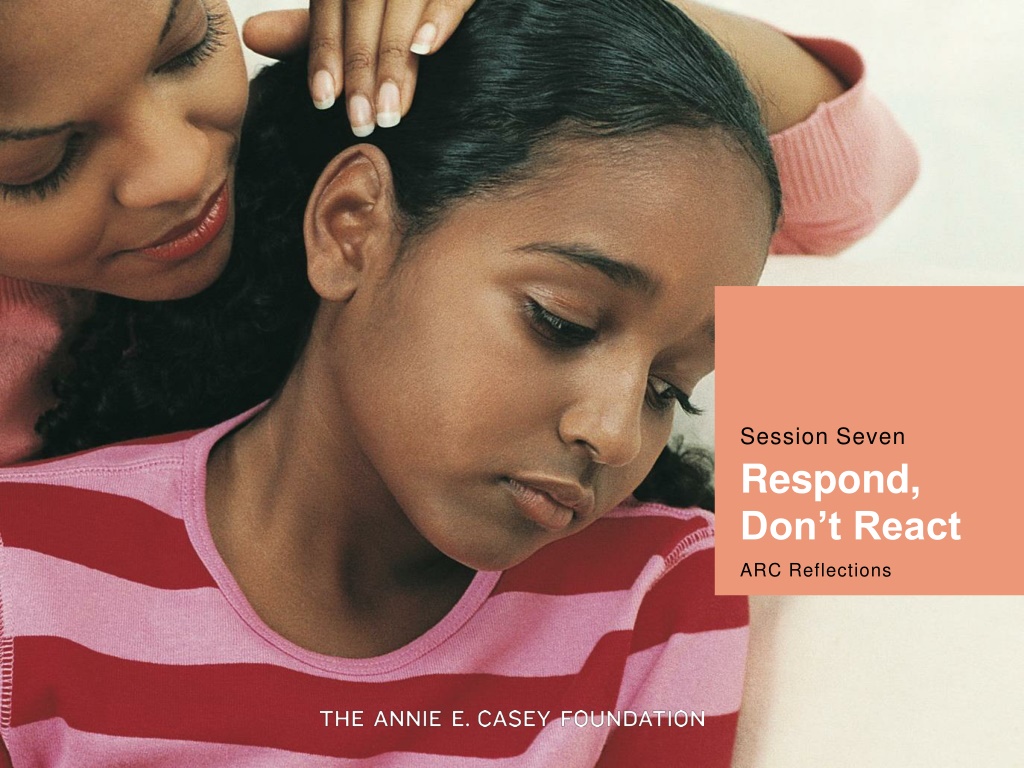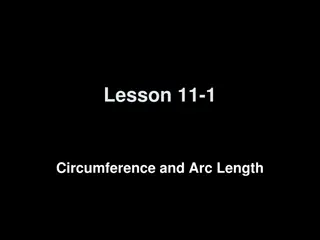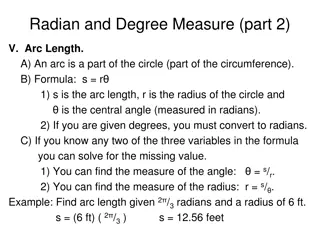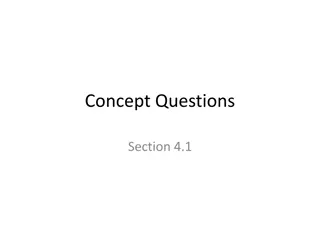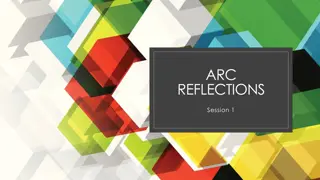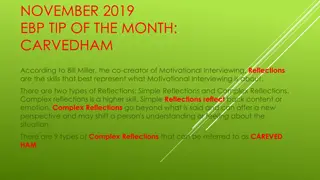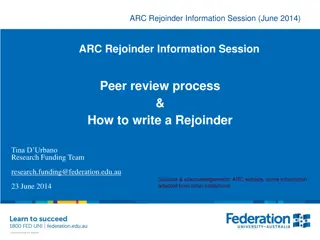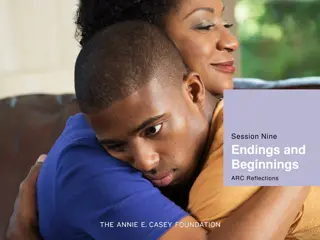Understanding ARC Reflections: Responding with Care
ARC Reflections is a framework designed to support children and teens who have experienced trauma. Developed by Margaret Blaustein and Kristine Kinniburgh, it focuses on Attachment, Regulation, and Competency. The program involves caregiver training and aims to build resilience in families dealing with trauma through a series of group sessions. Each session includes various activities like warm-ups, self-reflection, and take-home practices to help participants better understand and respond to challenging situations.
Uploaded on Oct 05, 2024 | 0 Views
Download Presentation

Please find below an Image/Link to download the presentation.
The content on the website is provided AS IS for your information and personal use only. It may not be sold, licensed, or shared on other websites without obtaining consent from the author. Download presentation by click this link. If you encounter any issues during the download, it is possible that the publisher has removed the file from their server.
E N D
Presentation Transcript
Session Seven Respond, Don t React ARC Reflections
ARC Reflections ARC, or Attachment, Regulation and Competency, is a framework for working with children and teens who have experienced trauma. Developed by Margaret Blaustein and Kristine Kinniburgh of the Justice Resource Institute, ARC builds on the resilience of children, teens and families ARC Reflections an ARC-informed caregiver training curriculum for foster parents, kin and other caregivers was written by Blaustein and Kinniburgh with support and consultation from the Annie E. Casey Foundation 2
Welcome This group will meet nine times for two hours each time Please attend all sessions Each session will include the following segments: Warm-up Opening check-in Review and report back Theme of the day Self-reflection Take home Practice Closing check-in 3
Count Up How many people are in the room? Your goal is to cooperatively count to that number, out loud, as a group Any person can start; any person can say a number but only one person can say a number at a time If more than one person says a number, you must start over How many tries does it take to be successful? 5
What Is Your Energy Right Now? Totally Comfortable Great Match +10 +5 0 z -5 -10 Really Terrible Match Uncomfortable 7
Getting Comfortable If your energy is comfortable and a good match, great! If not, what can you do to get it there? 8
Review Remember how infants and young kids learn how to regulate It is much harder for kids and teens who don t have enough soothing when they are young to manage feelings and behavior To help: Lay a good foundation. Use routines and other ongoing, soothing strategies. Connect with the child or teen and learn his or her patterns Respond in the moment. Read clues, use your self- care tools, support the child using his or her tools, offer opportunities for control and reconnection 10
Report Back In small groups, discuss what you practiced What went well? What was challenging? What was something you noticed? 11
Remember These? In an earlier session, we identified challenging behaviors you encounter at home Are there other behaviors you want to add to the list? Do these behaviors still feel as challenging? Why or why not? What are some of your typical responses? What strategies do you use to try to address these behaviors? 13
Childrens Behavior Can Be Hard Many young people who have experienced trauma struggle with behaviors that challenge us, push our buttons, are hard to redirect and may feel disruptive to home life You may feel your strategies are maxed out, especially when what works with one child or teen does not work with another and what worked yesterday doesn t work today 14
Why Are Some Behaviors So Hard to Change? Remember the sequence that drives the behaviors: Lens: The world is dangerous Function: Survival Ability to respond: Too few internal or external resources Nothing is as hard to change as the behaviors we develop to help us survive 15
Adult Responses Are Hard to Shift, Too What are some of your core values and household expectations? Consider: Respect, courtesy, honesty, patience, appreciation Negative child or teen behavior often leads adults to believe children or teens are disrespectful, don t appreciate and don t value our relationships Caregivers can then get caught in emphasizing appropriate behavior in an attempt to teach values 16
Understanding Childrens and Teens Needs and Values (Ours, Too) NEEDS VALUES Growth, potential, exploration Self-actualization Esteem Achievement, respect, independence Love and belonging Community, relationships Survival, avoiding danger Safety Survival, fulfilling core needs Physiological (bodily needs) Adapted from Maslow s Hierarchy of Needs (1943) 17
Understanding Childrens and Teens Needs and Values (Ours, Too) NEEDS AND VALUES BEHAVIORS Trying new things, experiencing success Growth, potential Reciprocity, independence Respect, achievement Cooperation, gratitude, engagement Community, relationships Aggression, running away, lying, tantrums Survival, danger avoidance Stealing, hoarding, sexualized behavior Physiological (bodily needs) Adapted from Maslow s Hierarchy of Needs (1943) 18
Toolbox: Approaches to Behavior Be proactive Identify the child s or teen s patterns Use your go-tos: Meet needs Support regulation Purposefully identify your other strategies, such as praise and reinforcement, problem solving and limit setting 19
Checking In With Olivia Olivia is 7 years old. She continues to steal small items and hoard food in her new foster home She can be affectionate with her foster parents, but gets overwhelmed, clingy and demanding when asked to do small tasks. At times, her anger increases and she throws things at her foster mother She appears to be settling into her new bedtime routine but has a hard time separating at lights out and her anxiety can escalate, which can spur a lengthy tantrum 20
Be Proactive Children or teens who have experienced trauma are complex They may have challenging behavior They may have different states Their responses in relationships may be uneven 21
Ways to Be Proactive Identify a limited number of behaviors (no more than three) to focus on Consider positive behaviors those you want to see more of not just those you want to reduce Olivia s foster parents decide to focus on those that were most challenging to them: Hoarding Bedtime separation Throwing objects 22
Identify the Childs or Teens Patterns Use your detective skills: Read the clues that tell you about your child s or teen s needs, feelings and experiences Remember the function of children s and teens trauma-driven behavior: Survival (fight, flight, freeze, submit) Need fulfillment (emotional, relational and physiological needs) 23
Thinking About Olivia What needs might be behind Olivia s: Hoarding? Bedtime separation anxiety? Throwing objects? 24
What Might Olivias Needs Be? Hoarding Is it about fulfilling a need? Does she fear not having enough to eat? Is it a survival strategy? Bedtime separation anxiety Does she need relational reassurance? Is she afraid of the dark or of being alone or does she worry her foster parents won t be there when she wakes up? Does she have difficulty with transitions? Throwing objects Is this a survival response? An attempt to get attention or help, or create space for herself? 25
Use Your Go-Tos: Meet the Childs Needs Once laid down by trauma, needs are experienced on a deep level and may need to be met many times, in many ways, for the need to decrease Meeting needs does not mean you cannot address behaviors in other ways and it does not reinforce the negative behaviors: it gets in front of them and, ideally, decreases the behaviors Once you identify a child s or teen s needs, experiment with ways to meet them 26
Meeting Olivias Needs Every time Olivia s foster parents cleaned, they found old, uneaten, often rotten food in drawers and behind the bed. Establishing consequences was not effective Working with Olivia s therapist, her foster parents: Identified a kitchen drawer and filled it with healthy snacks. They made it Olivia s drawer; only she could take food from it. They regularly made sure it was full Put a food-safe garbage can in her room for any food- related products Stopped talking about the issue 27
Meeting Olivias Needs Throwing objects was often the result of a request for Olivia to complete simple chores or self-care. When Olivia escalated, it was hard for her foster parents not to do the same thing Olivia s therapist guessed throwing might be a request for support, not distance As an experiment, Olivia s foster mom began to do chores with her. She d ask, Olivia, which toys should we pick up first? Eventually, Olivia was able to complete many tasks independently when her foster mother was in the room and available 28
Use Your Go-Tos: Support Regulation Sometimes, your first clue that a need is not being met is dysregulation a signal that the child s or teen s brain has begun to shift into survival mode At this point, your primary goal is to support regulation and shift the child or teen (and yourself, if necessary!) out of survival mode and into a more regulated state (off of the Express Road and back to the main road) A regulation break may be enough to shift negative behaviors before they have a chance to start 29
Use Your In-the-Moment Tools to Support Regulation As a reminder, use your in-the-moment skills in moments of escalation: - Meet the child s or teen s need (if you can identify it) Catch the moment as early as possible - Offer control and choices Check in and use your own self-regulation tools - Reconnect Be a mirror 30
Target Your Use of Strategies Purposefully Think about the strategies in your behavioral toolbox and use them purposefully. Ask, which is appropriate to the moment? Think of your strategies as experiments. Understand that one strategy will not work for all kids all the time Multiple strategies can be used to address the same behavior at different times Over the next several slides, we will discuss three possible behavioral strategies 31
Praise and Reinforcement Why use praise and reinforcement? To build children s and teen s awareness of their successes and positive capacities To focus yourself on a child s or teen s strengths and potential for success rather than focusing on their bad behavior When should you use praise and reinforcement? Any time a child or teen is engaging in a behavior you want to increase (often, the opposite of what you want to decrease) 32
Praise and Reinforcement How should you use praise and reinforcement? Use words. Be specific. Label the behavior I am so proud of you for using your tools to calm down You did such a good job listening when I asked you to clean up Show pride and appreciation (nonverbally) Use reinforcement charts or concrete rewards 33
Praise and Reinforcement: Trauma Considerations Praise can be a trigger for some children or teens who have experienced trauma If a child or teen rejects or ignores your praise, try not to take it personally and don t engage in a power struggle If a child or teen seems triggered by praise, try focusing on the positive behaviorinstead of the whole child ( You worked so hard on that drawing vs. What a good artist you are ) Keep noticing the positives. Even for a child or teen who seems distressed or unresponsive, over time the positives will matter 34
Problem Solving Why engage children and teens in problem solving? To build children s and teens awareness of having and making choices and learn that they can get in front of, not just react to, some challenges To help children and teens feel more in control of and powerful over their lives When can children and teens be engaged in problem solving? When children and teens are calm, before or after situations in which challenges are likely or have occurred When the child or teen is asking you for help Regularly. Build children s and teens skills by practicing and addressing the many small challenges that arise day to day 35
Problem Solving How can children and teens be engaged in problem solving? Share your interest in supporting the child or teen and your belief in a solution ( Let s figure this out ) Help the child or teen identify the problem ( What is it you are trying to solve? ) Identify goals or desired outcomes ( What do we want to happen? ) Identify choices ( What different things can we do? ) Identify consequences ( What might happen if we do that? ) Make a plan and be a troubleshooter. Stay in the adult support role 36
Problem Solving: Trauma Considerations A child s or teen s ability to engage in problem solving depends on: Whether he or she feels powerful enough to make a choice, or believes he or she has one Which part of the brain is online His or her stage of development Your ability to be calm and use this approach at appropriate times and provide ongoing support are crucial. Very few children or teens can problem solve independently 37
Limit Setting Why use limit setting? To establish an understanding of boundaries, expectations and a safe world To help children and teens contain and shift negative behaviors and identify positive alternatives To help children and teens learn where the lines are with inappropriate behaviors When should you use limit setting? When a child s or teen s behavior crosses established boundaries related to safety, harm to others or harm to the child or teen Thoughtfully and not for every behavior 38
Limit Setting How to set limits? When you are calm, if possible Identify thoughtful, age-appropriate limits in advance of behavior occurring If you name consequences for certain behavior: Do so when the child or teen is reasonably calm Less is more. Be concise and clear; link consequences to the behavior, not the child or teen Move on when you can. Allow the child or teen to be angry about a consequence but also create space for relationship repair. Use your own self-care tools 39
Limit Setting: Trauma Considerations Any limit can be a potential trigger for a child or teen who has experienced trauma Choose consequences carefully. Time-out may not be the right approach for a child or teen with a neglect history; yelling may trigger a child or teen who has experienced violence Tune into your child or teen to name feelings, even as you set limits ( It makes sense that you were angry, but we use our words, not our hands, when we are mad ) Separate the behavior from the child or teen 40
Problem Solving Behavior: Throwing things at foster mom when overwhelmed Olivia s foster mother sat with Olivia when she was calm during their evening chat time. They talked about how everyone in the home was an important part of the family and contributed to keeping the house running smoothly The foster mom noted that chores were hard for Olivia and asked if they could figure out a way to help Olivia feel more successful at doing them When Olivia had a hard time generating ideas, her foster mother suggested that the two of them practice doing some chores together. She also talked about ways Olivia could tell her she was feeling overwhelmed 41
Praising Effort Olivia s foster parents worked hard to notice and comment positively on any instances in which Olivia did something around the house, such as cleaning up her toys, putting clothes in the laundry or doing age-appropriate self-care tasks such as brushing her teeth They also began to tune in and name moments when Olivia got upset but not aggressive and praised her for using her regulation tools 42
Setting Limits Whenever Olivia escalated to throwing things, the parent immediately stopped the activity and mirrored Olivia s affect or energy ( I see you are upset, or Your energy just got really big ) and suggested a break If that didn t work, an adult would carry Olivia to the calm-down corner and stay until she was calm. They would discuss that it is OK to be angry but not to throw things; thrown toys would go into a toy time-out for 10 minutes 43
Seeing Success Using problem solving Over time, Olivia and her foster parents identified early warning signs that Olivia was having a hard time and used a special silly phrase ( purple-spotted dinosaur ) that cued Olivia to use her calm-down corner. They also built regular chore times into her daily routine Using praise and reinforcement Whenever Olivia went to her corner when cued, used coping skills or completed chores successfully, the adults gave her a high-five or verbal praise 44
Wrap-Up Behavior is driven by children s or teens needs. Needs are hierarchical and vary depending on the state the child or teen is in at the moment To be successful, respond, don t react Be proactive Identify the child s or teen s needs Use your go-tos Identify your other strategies purposefully 45
Question Think of a child s or teen s behavior you have been struggling with. What strategies are you trying at the moment? After today s discussion, why do you think your current approach is or is not working? 47
TAKE HOME What is one sentence (idea, concept or something you have learned) that you can take away from today? Write it in your log.
